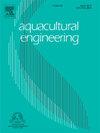基于GBDT-NSGAII算法和计算流体动力学的圆形养殖鱼缸进出口多目标优化
IF 4.3
2区 农林科学
Q2 AGRICULTURAL ENGINEERING
引用次数: 0
摘要
在循环水产养殖系统(RAS)的圆形养殖池中,流体力学对水产品的生长发育起着至关重要的作用。保持最大有效能量利用率和实现均匀的速度分布仍然是一个重大挑战。为解决这一问题,采用了一种新颖的多目标优化方法,利用梯度提升决策树-非支配排序遗传算法 II(GBDT-NSGAII)算法,优化养殖水槽的进水口和出水口参数,以实现合适的水动力。具体而言,以初始圆形培养槽为基准,通过 CFD 模型研究了圆形培养槽的四个重要参数,包括喷嘴数量、喷嘴直径、出口直径和入口角度。建立基于 GBDT-NSGA-II 的模型并进行参数优化,以获得帕累托前沿,目标是最大化有效能量利用率,同时最小化速度 STD。主要结果表明1) 在入口速度为 0.5 米/秒时,该基准成功地建立了动态均质速度场,同时在入口管道中显示出主要受喷嘴直径影响的高压力域。2) GBDT 模型对 CFD 数据库具有出色的预测能力,平均速度的 RMSE 为 0.002 m/s,速度 STD 的 RMSE 为 0.304 %。4) 最佳的入口-出口参数组合主要包括 0.49 m/s 的入口速度和 22.26 mm 的出口直径,与基准模型相比,能量利用率提高了 88%。由 CFD 仿真数据集驱动的 GBDT-NSGA-II 模型可有效替代复杂的 CFD 计算,节省计算机资源,在准确预测 RAS 循环养殖池的流体力学方面表现出了值得称道的性能。本文章由计算机程序翻译,如有差异,请以英文原文为准。
Multi-objective optimization of inlet and outlet in a circular culture fish tank using the GBDT-NSGAII algorithm and computational fluid dynamic
In a circular culture tank, hydrodynamics plays an essential role for the growth and development of aquatic products in the recirculating aquaculture system (RAS). The challenge of maintaining the maximum effective energy utilization rate and achieving uniform velocity distributions remains a significant hurdle. To solve this problem, a novel multi-objective optimization approach was employed, utilizing the Gradient Boosting Decision Tree-Non-Dominated Sorting Genetic Algorithm II (GBDT-NSGAII) algorithm, to optimize the parameters of inlet and outlet of culture tanks as achieving suitable hydrodynamics. Specifically, the initial circular tank is regarded as the benchmark, four vital parameters of circular tank including nozzle quantities, nozzle diameters, outlet diameters, and inlet angles has been investigated by CFD model. The development of a GBDT-NSGA-II-based model and parameter optimization is conducted to obtain the Pareto front, with the objective of maximizing effective energy utilization rate while minimizing velocity STD. The main results show that: 1) At an inlet velocity of 0.5 m/s, the benchmark successfully establishes dynamic homogeneous velocity fields, while exhibiting a highly pressurized domain in the inlet pipe primarily influenced by the nozzle diameter. 2) The GBDT model demonstrates excellent predictive capability for the CFD database, with an RMSE of 0.002 m/s for average velocity and an RMSE of 0.304 % for velocity STD.3) The diameter of nozzles (12.76 mm) and the number of nozzles (7) have a highly significant influence on both average velocity and velocity uniformity compared to the benchmark model among the 63 groups of optimal Pareto fronts. 4) The optimal inlet-outlet parameter combination mainly includes an inlet velocity of 0.49 m/s and an outlet diameter of 22.26 mm, which improves the energy utilization rate up to 88 % compared to the benchmark model. The GBDT-NSGA-II model, driven by CFD simulation dataset, can effectively replace complex CFD calculations and save computer resources, exhibit commendable performance in accurately predicting the hydrodynamics of circular culture tanks in RAS.
求助全文
通过发布文献求助,成功后即可免费获取论文全文。
去求助
来源期刊

Aquacultural Engineering
农林科学-农业工程
CiteScore
8.60
自引率
10.00%
发文量
63
审稿时长
>24 weeks
期刊介绍:
Aquacultural Engineering is concerned with the design and development of effective aquacultural systems for marine and freshwater facilities. The journal aims to apply the knowledge gained from basic research which potentially can be translated into commercial operations.
Problems of scale-up and application of research data involve many parameters, both physical and biological, making it difficult to anticipate the interaction between the unit processes and the cultured animals. Aquacultural Engineering aims to develop this bioengineering interface for aquaculture and welcomes contributions in the following areas:
– Engineering and design of aquaculture facilities
– Engineering-based research studies
– Construction experience and techniques
– In-service experience, commissioning, operation
– Materials selection and their uses
– Quantification of biological data and constraints
 求助内容:
求助内容: 应助结果提醒方式:
应助结果提醒方式:


